Journal of Animal Health and Production
Research Article
Nasturtium Plant is a Potential Candidate for Management of Male Reproductive Disorders
Eman Saad*, Sayed Abdel Aziz, Ahmed A. Said, Mahmoud A. Said
Department of Pharmacology, Faculty of Veterinary Medicine, Zagazig University, Egypt.
Abstract | Nasturtium plant (Tropaeolum majus) has various health advantages and uses. It’s known for wound healing properties. Some controversial data reported its effect on the reproductive system. This study aims to identify the extent of the effect of nasturtium plant on the reproductive system of male albino rats. Sixty adult male albino rats were used and divided into 3 equal groups. The first group was left as control and received distilled water orally. The second group and the third group received hydroethanolic extract of nasturtium flowers and leaves 250mg/kg BW via oral gavage daily for 4 weeks. On days 10, 20 and 30 post treatments, 5 rats from each group were sacrificed and blood samples were collected to extract serum for biochemical analysis. Sex organs were collected and weighed to calculate weight index and parts of them were used for histopathological examination. Herein, on day 10 post-treatment the serum testosterone levels in animals received flowers and leaves extract were significantly (p < 0.05) lower (0.935±0.333 and 0.86±0.26, respectively) than that of the control group (3.75±0.35). Serum follicle stimulating hormone (FSH), luteinizing hormone (LH) and sperm count of rats received nasturtium leaves and/or flowers were significantly (p < 0.05) higher up to 30 day post treatment than the control group. The serum level of prolactin and sex organ indices of rats were reduced (p < 0.05) by the treatment of nasturtium plant. Histopathological data showed some necrotic changes accompanied by arrest of spermatogenesis. It was concluded that nasturtium plant as a natural herbal medicine has significant effects on reproductive system, however further research is recommended to know its cytotoxic effects as evidenced by our histopathological results.
Keywords | Histopathology, Nasturtium, Testis, Testosterone, Sex hormones
Received | July 21, 2021; Accepted | August 08, 2021; Published | August 25, 2021
*Correspondence | Eman Saad, Department of Pharmacology, Faculty of Veterinary Medicine, Zagazig University, Egypt; Email: Eman.elassal89@gmail.com
Citation | Saad E, Aziz SA, Said AA, Said MA (2021). Nasturtium plant is a potential candidate for management of male reproductive disorders. J. Anim. Health Prod. 9(s1): 26-33.
DOI | http://dx.doi.org/10.17582/journal.jahp/2021/9.s1.26.33
ISSN | 2308-2801
Copyright © 2021 Eman Saad et al. This is an open access article distributed under the Creative Commons Attribution License, which permits unrestricted use, distribution, and reproduction in any medium, provided the original work is properly cited.
INTRODUCTION
Recently, male reproductive disorders including prostate hypertrophy and testicular cancer are still challenging and spread. They have increased in number in the last five years, especially in Europe and USA (Stamatio et al., 2020). Some data reported that Africa is one of the most continents affected by reproductive disorders, especially in males (Niels, et al., 2016). Male reproductive disorders is caused by several factors such as life style, prolonged exposure to contaminants and could be genetic or even idiopathic (Agbodjento, et al., 2020).
Because of the adverse effects caused by anti-androgenic drugs and hormonal replacement therapy, the use of complementary and alternative medicines (CAMs) has increased in management of this type of disorder (Bardaweel et al., 2013). Some medicinal plants have been discovered, but they are limited to certain areas because of a little scientific research (Smith, et al., 2010). The interest in using herbal medicine in spite of the presence of synthetic treatments may be accounted for the belief that they have less or no side effects (Ozen, 2009). The plant nasturtium (Tropaeolum majus L.) belongs to the Tropaeolaceae family and usually is an ornamental plant. The plant is known under many names like garden nasturtium, Indian cress or monks’ cress (Freitas, et al., 2013). Nasturtium is considered one of the ornamental plants. Many research articles reported that it has many therapeutic benefits e.g. promotion of wound healing, antibacterial, immunostimulant due to its rich content of flavonoids (Lourenço et al., 2012).
The effects of nasturtium plant on male and female reproductive physiology and fertility are largely controversial. Available in vivo studies exhibited negative (Said and Saad, 2021), positive (Akbari Bazm et al., 2019) and no effects (Lourenço et al., 2012) of this plant on reproductive system, that demands further research to clarify the effects of this plant on reproductive physiology and organs. Therefore, the purpose of this study was to investigate the possible effect of nasturtium plant on the reproductive system of the adult male albino rats using biochemical and histopathological techniques.
MATERIALS AND METHODS
Experimental animals
Sixty adult male albino rats, Westar strain weighing 180-200g were used. They were obtained from the Laboratory Animal farm of Faculty of Veterinary Medicine, Zagazig University, Egypt. They were left to acclimatize in stainless–steel cages at a suitable temperature and humidity for 7 days. They were put under standard hygienic conditions, fed on a balanced ration and given clean tap water ad libitum. The care and welfare of animals conformed to the guidelines of the Animal Use Research Ethics Committee of Zagazig University, Egypt.
Preparation of hydro- alcoholic extract of Tropaeolum majus flowers and leaves
Nasturtium flowers and leaves were obtained from some local gardens. The plant was identified by Prof. Dr. Ali meowed Professor of horticulture, Faculty of Agriculture Zagazig University. Flowers and were cleaned, dried at 50ᵒC and then grinded to a powdered form prior to extraction and stored at the refrigerator under 4-5 to avoid risk of degradation and contamination. The hydro ethanolic solvent contains 2 L of 70% ethanol: 30% water (70:30 ratios). One kilogram of leaves and one kilogram of flowers were used. The calculated amount of flowers and leaves was left to be air dried in the dark and then soaked in the solvent for 4 days. After 4 days, the extract was filtered and concentrated under reduced pressure using a rotatory evaporator and then the extract of both flower and leaves yielded 10 gm (Jamshid, et al., 2017). The residual content was transferred to petri dish and was kept in an oven at 40 for drying up. The hydro ethanolic extract was kept at -20 until use.
Experimental design
Sixty adult male albino rats were used and divided into 3 equal groups. The first group (n=20) was left as a control and received only distilled water orally. The second group and the third group (n=20 each) received hydroethanolic extract of nasturtium flowers and leave (250 mg/kg) via oral gavage daily for 4 weeks.
At the end of the experiment, 5 rats from each group were sacrificed and blood samples and sex organs were collected on day 10, 20 and 30 post-treatments. The blood samples were left in a dry test tube for centrifugation for 15 minutes at 3000 r.p.m to obtain serum to estimate follicle stimulating hormone (FSH) and luteinizing hormone (LH), total testosterone as well as prolactin. Sex organs were collected from each group for weight and histopathological examination.
Biochemical analysis of serum FSH, LH and Total testosterone
The quantitative determination of serum testosterone, LH, and FSH carried out in plasma by commercial kits according to the manufacturer’s instructions (Elabscience, Wuhan, China, and SunRed, Shanghai, China).
Histopathological study
Seminal vesicles, prostate and testis were kept in a jar containing 10% neutral formalin for 24 hours. They were processed in an automated tissue processor. Paraffin sections (4–5 um) were stained with hematoxylin and eosin. Stained sections were examined for inflammatory reactions, degenerative, necrotic, apoptotic changes and any other pathological lesions in the examined tissues of experimental rats (Suvarnet et al., 2013).
Statistical analysis
The obtained data were analyzed and graphically represented using the statistical package for social science (SPSS, version 16), for obtaining [Mean value ± standard error]. The results were statistically analyzed by using one-way ANOVA test. Subsequent multiple comparisons between the different groups were analyzed by Duncan’s multiple comparison tests. Values at p < 0.05 were considered significant (Armitage et al., 2008).
RESULTS
Effect of oral administration of nasturtium flowers and leaves extract on sex organ indices
It was clearly evident from Table (1) that the oral administration of hydro-ethanolic extract of nasturtium leaves and flowers extract daily for successive 30 days in a dose of 250 mg /kg BW caused a significant (p < 0.05) decrease in index weight of testicles on days 20 and 30 days post treatm-
Table 1: Effect of oral administration of nasturtium flowers and leaves extract (250mg/kg BW) for 30 consecutive days on index weight of sex organs (Mean+S.E).
| Weight index after treatment (g) | |||||||||
| 10 days | 20 days | 30 days | |||||||
| Groups and Treatment | Testicle | Prostate | Seminal vesicle | Testicle | Prostate | Seminal vesicle | Testicle | Prostate | Seminal vesicle |
| Control |
0.988 ±0.052a |
0.016 ±0.002b |
0.493 ±0.056a |
0.988 ±0.052 |
0.016 ±0.002c |
0.493 ±0.056a |
0.988 ±0.052a |
0.016 ±0.002b |
0.493 ±0.056a |
| Nasturtium flower |
0.850 ±0.075ab |
0.028 ±0.005a |
0.413 ±0.019ab |
1.003 ±0.056 |
0.056 ±0.020a |
0.420 ±0.027ab |
0.655 ±0.108b |
0.114 ±0.008b |
0.398 ±0.020ab |
| Nasturtium leaf |
0.928 ±0.061ab |
0.014 ±0.001b |
0.348 ±0.018b |
1.028 ±0.075 |
0.02 ±0.002b |
0.425 ±0.025ab |
0.648 ±0.059b |
0.132 ±0.015a |
0.393 ±0.028ab |
Mean values with different superscripts in the same column are significantly different at p<0.05.
Table 2: Effect of oral administration of nasturtium flowers and leaves extract (250mg/kg BW) for 30 consecutive days on semen picture of mature male rats (Mean+S.E).
| Sperm motility % after treatment |
Sperm count (125x104) after treatment |
|||||
| Treatment Groups | 10 days | 20 days | 30 days | 10 days | 20 days | 30 days |
| Control |
87.5 ±1.443a |
87.5 ±1.443a |
87.5 ±1.443a |
30.0 ±1.83b |
30.0 ±1.83c |
30.0 ±1.83c |
| Nasturtium flower |
85.0 ±2.041a |
78.75 ±5.154ab |
87.5 ±1.443a |
43.5 ±2.72a |
52.75 ±3.57a |
68.5 ±5.33a |
| Nasturtium leaf |
76.25 ±2.239b |
80.0 ±4.08ab |
82.5 ±1.443ab |
29.75 ± 3.43b |
47.5 ±2.90b |
53.25 ±4.423b |
Mean values with different superscripts in the same column are significantly different at p<0.05
-ent and non-significant (p > 0.05) changes on 10th day compared with control group. Whereas, the same table showed a significant (p < 0.05) increase in index weight of prostate of leaves and flowers taking group groups on the 20th and 30th day post treatment compared with control group together with non-significant (p > 0.05) changes at 10th and 20th day post end of treatment. Meanwhile, the index weight of the seminal vesicles showed a significant (p < 0.05) decrease only in the group given leaves extract on the 10th day post-treatment.
Effect of oral administration of nasturtium flowers and leaves extract on sperm motility and count
The sperm motility in both treated groups showed non-significant (p > 0.05) changes along the entire period of the study except on 10th day post end of treatment in response to both extracts compared with control group. The sperm count was significantly (p < 0.05) increased in all groups treated with both extracts along the entire course of the study except on 10th day post end of treatment with leaves extract which showed a non-significant (p > 0.05) change compared with control group (Table 2).
Effect of oral administration of nasturtium flowers and leaves extract on sex hormones
Effect on FSH hormone: It has been revealed that serum FSH was significantly (p < 0.05) elevated in the group given the flower extract on 20 and 30 days post end of treatment compared with control whereas, it showed non-significant (p > 0.05) increase on 10th day as well as along the entire period of the study in the group given leaves extract (Table 3).
Table 3: Effect of oral administration of nasturtium flowers and leaves extract (250mg/kg BW) for 30 consecutive days on serum FSH hormone (MIU/ml) of mature male rats. (Mean ±S.E)
| FSH hormone (MIU/ml) | |||
| Treatment Groups | 10 days | 20 days | 30 days |
| Control |
0.35 ±0.029b |
0.35 ±0.029c |
0.35 ±0.029c |
| Nasturtium flower |
0.45 ±0.096a |
0.575 ±0.085a |
0.60 ±0.07a |
| Nasturtium leaf |
0.45 ±0.065a |
0.475 ±0.075b |
0.45 ±0.05b |
Mean values with different superscripts in the same column are significantly different at p<0.05
Effect on LH hormone: It was apparent from Table (4) that serum levels of LH hormone of rats receiving both extracts was significantly (p < 0.05) higher than control group along the entire period of the study in response to both extracts compared with control group except with the
Table 4: Effect of oral administration of nasturtium flowers and leaves extract (250mg/kg BW) for 30 consecutive days on serum LH hormone (MIU/ml) of mature male rats. (Mean±S.E)
| LH hormone (MIU/ml) | |||
| Treatment Groups | 10 days | 20 days | 30 days |
| Control |
0.105 ±0.003c |
0.105 ±0.003c |
0.105 ±0.003b |
| Nasturtium flower |
0.375 ±0.063ab |
0.35 ±0.065a |
0.225 ±0.025a |
| Nasturtium leaf |
0.468 ±0.062a |
0.125 ±0.025b |
0.103 ±0.003b |
Mean values with different superscripts in the same column are significantly different at p<0.05
Table 5: Effect of oral administration of nasturtium flowers and leaves extract (250mg/kg BW) for 30 consecutive days on serum prolactin (ng/ml.) of mature male rats (Mean ± S.E)
| Serum prolactin (ng/ml) | |||
| Treatment Groups | 10 days | 20 days | 30 days |
| Control |
1.163 ±0.094a |
1.163 ±0.094a |
1.163 ±0.094a |
| Nasturtium flower |
0.853 ±0.064ab |
0.875 ±0.063ab |
0.935 ±0.096ab |
| Nasturtium leaf |
1.185 ±0.212a |
0.945 ±0.032ab |
0.618 ±0.044b |
Mean values with different superscripts in the same column are significantly different at p<0.05
Table 6: Effect of oral administration of nasturtium flowers and leaves extract (250mg/kg BW) for 30 consecutive days on serum testosterone (ng/ml) of mature male rats (Mean+S.E).
| Serum total testosterone (ng/ml) | |||
| Treatment Groups | 10 days | 20 days | 30 days |
| Control |
3.75±0.35a |
3.75±0.35a |
3.75±0.35a |
| Nasturtium flower |
0.935±0.33b |
1.04±0.10b |
1.10±0.24b |
| Nasturtium leaf |
0.86±0.26b |
1.65±0.25b |
0.89±0.08b |
Mean values with different superscripts in the same column are significantly different at p<0.05
leaves extract on 20th and 30th day post –end of treatment which showed non-significant (p > 0.05) changes.
Effect on serum prolactin: The serum prolactin level was non-significantly (p > 0.05) changed along the entire period of the study in response to both flower and leaves extract (Table 5).
Effect on serum total testosterone: A significant (p < 0.05) decrease in serum testosterone level was reported along the entire period of the study in response to flower and leaves extract compared with control group (Table 6).
Histopathological results
Effect of oral administration of nasturtium flowers and leaves extract on testicles of male albino rats: Figure 1A showed a normal semineferous tubules with active spermatogenesis and the testicular seminiferous tubules covering tunica albuginea appeared. On the 10th day post oral administration of flower extract of nasturtium, Figure 1B revealed that the majority of seminiferous tubules showed moderate spermatogenesis and congested blood vessels and interstitium and tunica albuginea. After 20 days, post oral administration of flower extract of nasturtium, mild spermatogenesis and degenerate spermatocytes with congested blood vessels were evident. Some seminiferous tubules exhibited mild spermatogenesis beside edema and congested blood vessels were also observed (Fig.1C).
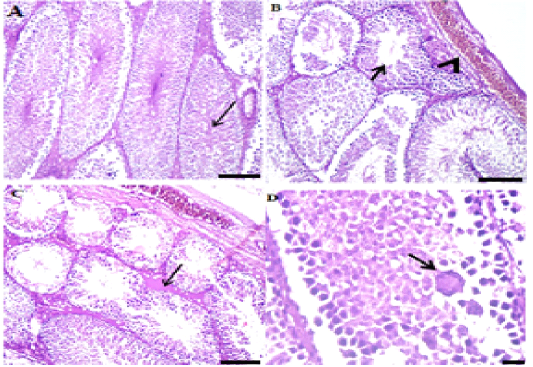
Figure 1: A: Photo micrograph of male rat testis (control) showing normal semineferous tubules and active spermatogenesis and the testicular seminiferous tubules and covering tunica albuginea appeared normal. (H&E; x 100). B: Photo micrograph of male rat Testis reveals moderate spermatogenesis (arrowhead) of congested blood vessels in tunica albuginea, The majority of seminiferous tubules showed moderate spermatogenesis and congested blood vessels and in interstitium and tunica albuginea (H&E; x100). C: Photo micrograph of male rat Testis showing mild spermatogenesis and degenerated spermatocytes (thin arrow) with congested blood vessels (thick arrow), some seminiferous tubules exhibited mild spermatogenesis besides edema and congested blood vessels (H&E x100). D: Photo micrograph of male rat testis showing intense degenerated necrotic spermatocytes (thin arrow) with spermatid giant cells (thick arrows), the majority of tubules had vacuolated and degenerated or necrotized spermatogonial and spermatocytes beside spermatid giant cells (H&E; x400).
On day 30 post treatment, intense degenerated necrotic spermatocytes with spermatid giant cells, the majority of tubules had vacuolated and degenerated or necrotized spermatogonial and spermatocytes beside spermatid giant cells pronounced interstitial edema and congested blood vessels were present (Fig. 1D).
Effect of oral administration of nasturtium flowers and leaves extract on the seminal vesicles of male albino rats:
The histomorphological architecture of seminal vesicles of mature rats including tubuloalveolar glands and secretion, trabeculae and covering tunica was apparently normal as shown in Figure 2A. Ten days after oral administration of nasturtium flowers, distended glands with secretion and atrophy of their lining epithelium occurred (Fig. 2B). Moreover, tubuloalveolar glands became hyperplastic and containing moderate secretion on the 20th day post oral gavage (Fig. 2C). After 30 days, figure 2D revealed that the tubuloalveolar glands were hyperplastic and progressed until atrophy associated with intense and retained secretion
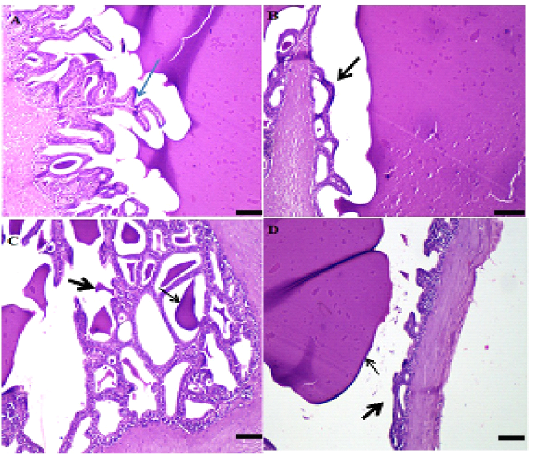
Figure 2: A: Photo micrograph of male rat seminal vesicle (control) showing normal tubule-alveolar glands and secretion, trabeculae and covering Tunica were normal (H&E x100). B: Photo micrograph of male rat seminal vesicle showing distended glands with secretion and distended ducts and glands with secretion with mild atrophy of some epithelial lining of a few glands (H&E; x100) . C: Photo micrograph of male rat Seminal vesicles showing hyperplastic tubuloalveolar glands (arrows) containing little secretion, normal tubule alveolar glands and some were hyperplastic and contain moderate secretion (double arrow) (H&E; x100). D: Photo micrograph of male rat Seminal vesicle showing atrophied tubular glands with retained secretion (arrows), a few tubuloalveolar glands lined by atrophied epithelium with intense secretion in its Lumina (H&E; x100).
Effect of oral administration of nasturtium flowers and leaves extract on prostate gland of male albino rats: Fig. 3A showed normal prostatic acini with secretion; the glandular tissue contains normal stroma. As presented in Figure 3B, after 10 days of oral administration of nasturtium flower prostate gland showed apparently normal acini containing secretion; all the glandular tissues containing secretion were normal.
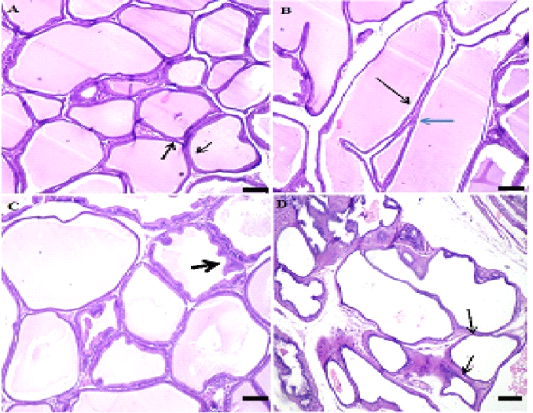
Figure 3: A: Photo micrograph of male rat Prostate (control) one day post end of administrated extract of nasturatium flower showing normal prostatic acini with secretion and the glandular tissue and stroma were normal (H&E; x100). B: Photo micrograph of male rat prostate gland (Flower I) Showing apparently normal acini containing secretion (both black and blue), all the glandular tissue contains secretion and were normal (H&E; x100). C: Photomicrograph of male rat prostate gland (Flower II) showing apparently normal acini containing little secretion (arrows), all glandular tissue appeared normal and contain a little secretion (H&E; x100). D: Photo micrograph of male rat Prostate (Flower III) showing cystic dilated prostatic acini devoid from secretion (arrow), some acini appeared cystic and lined by flattened epithelium and devoid from secretion (H&E; x100)
On day 20 post treatment, Figure 3C showed mild hyperplastic acini containing little secretion, all glandular tissue appeared normal and a few acini lined by hyperplastic epithelium and contain a little secretion, whereas some acini appeared cystic and lined by flattened epithelium and devoid secretion on day 30 post treatment (Fig. 3D).
Effect of oral administration of nasturtium flowers and leaves extract on the seminiferous tubules of male albino rats: Figure 4A is presenting normal seminiferous tubules and active spermatogenesis, seminiferous tubules, interstitium and covering were within normal morphological picture. On the 10th day post administration, prominent necrotic seminiferous tubules containing edema and necrotic debris (arrow) and interstitial edema, some seminiferous tubules were necrotic and contained edema and necrotic debris beside interstitial edema as shown in Figure 4B. After 20 days, the dose of nasturtium leaves 250mg/kg BW orally induced intense edema and necrosis of the seminiferous tubules and arrest of spermatogenesis with intense necrosis and edema inside their lumina severe edema and congested blood vessels in capsule and interstitium (Fig. 4C).
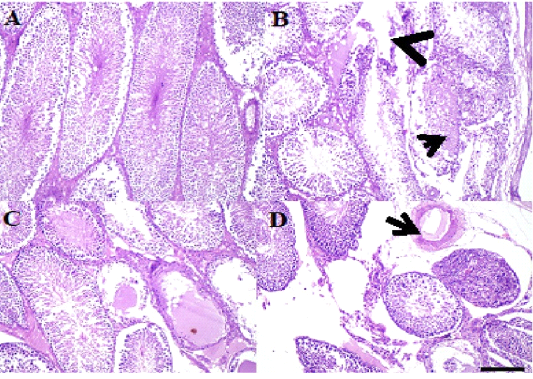
Figure 4: A: Photo micro graph of male rats (control) showing normal seminiferous tubules and active spermatogenesis, seminiferous tubules, interstitium and covering were within normal morphological picture (H&E; x100). B: Photo micro graph of male rat testis showing necrotic seminiferous tubules containing edema and necrotic debris (arrow) and interstitial edema (arrowhead), some seminiferous tubules were necrotic and contained edema and necrotic debris beside interstitial edema, A few tubules had pyknotic spermatogonia and spermatocytes with intense congestion and edema in the interstitium (H&E; x100). C: Photo micro graph of male rat showing intense edema and necrosis of the seminiferous tubules and arrest of spermatogenesis (arrows), the majority of tubules showed arrest of spermatogenesis with intense necrosis and edema inside their lumina severe edema and congested blood vessels in capsule and interstitium (H&E; x100). D: Photo micro graph of male rat testis showing spindle cell invasion for necrotic seminiferous tubules (arrows) and interstitial edema, the majority of necrotic acini invaded by spindle cells with mononuclear cells infiltration beside interstitial edema , other tubules collapsed with loss of thus lining epithelium and contained necrotic debris and threads. Dilated blood vessels with prominent edema in interstitium (arrow) (H&E; x100).
Regarding day 30 post administration, it was shown on Figure 4D that there was a spindle cell invasion for necrotic seminiferous tubules (arrows) and interstitial edema, the majority of necrotic acini invaded by spindle cells with mononuclear cells infiltration beside interstitial edema, other tubules collapsed with loss of thus lining epithelium and contained necrotic debris and threads. Intense congestion of blood vessels was prominent in capsule and interstitium.
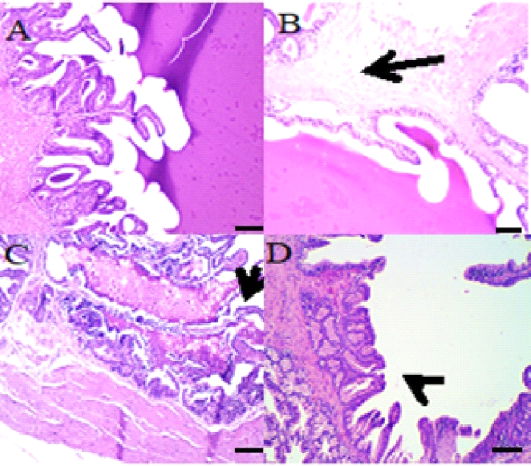
Figure 5: A: Photo micro graph of male rat seminal vesicle (control) showing normal tubuloalveolar glands and secretion, glandular structure, Trabeculae and covering tunica were normal (H&E; x100) . B: Photo micro graph of male rat Seminal vesicle showing normal tubule alveolar glands and edema in the smooth muscles, all the glandular structure appeared normal while tunica muscularis were edematous arrows (H&E; x100). C: Photo micro graph of male rat seminal vesicle showing partial desquamation of some glandular epithelium (arrows) and foamy secretion, some glands had partially desquamated epithelium and filled with foamy esinophilic colloidal secretion (H&E; x100). D: Photo micro graph of male rat seminal vesicle showing hyperplastic glands without secretion (arrows), tubuloalveolar glands were either hype plastic without secretion. Tunica muscularis had partial edema or necrosis (H&E; x100).
Effect of oral administration of nasturtium flowers and leaves extract on the seminal vesicle of male albino rats: The histomorphological architecture of the seminal vesicle of male rat including tubuloalveolar glands and secretion, glandular structure, trabeculae and covering tunica were apparently normal (Fig.5A). On day 10 post-treatment, it was evidenced from Figure 5B that the tubular alveolar glands and the glandular structure were normal, while the smooth muscles and the tunica muscularis were edematous. After 20 days of treatment, a partial desquamation of some glandular epithelium and foamy secretion appeared on Figure 5C, some glands had partially desquamated epithelium filled with foamy eosinophilic colloidal secretion. Then on the 30th day post administration it was clear that there were hyperplastic glands without secretion, tubuloalveolar glands were either hyper plastic without secretion or tunica muscularis had partial edema or necrosis (Figure 5D).
Effect of oral administration of nasturtium flowers and leaves extract on the prostate gland of male albino rats: The male rat prostate gland (control) showed normal prostatic acini with normal secretion of the acini, interstitium and muscles were normal (Fig. 6A). On day 10 post-administration, it was clear from figure 6B that the prostatic acini were normal with mild interstitial edema. Twenty days after oral gavage of nasturtium leaves extract, slightly cystic acini with little secretion occurred accompanied by mild dilated acini containing little secretion beside edema and congested blood vessels in interstitium (Fig. 6C). On the 30th day post treatment, it was shown on figure 6D that the cystic acini is without secretion and interstitial edema, cystic glandular acini devoid from their secretion and interstitial edema were common, other acini lined by hyperplastic epithelium.
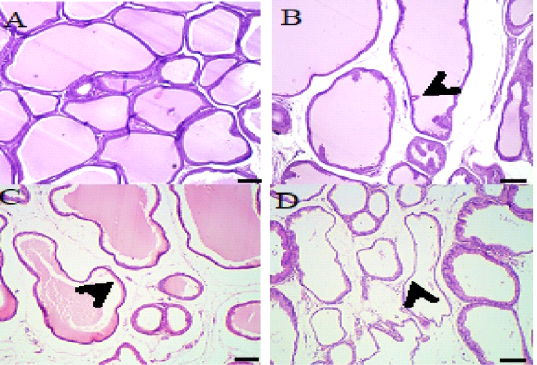
Figure 6: A: Photo micro graph of male rat Prostate gland (control) showing normal prostatic acini with secretion, the acini, interstitium and muscles were normal (H&E; x100). B: Photo micro graph of male rat prostate gland showing normal prostatic acini (arrows) and interstitial edema, the majority of prostatic acini contained secretion and normal beside interstitial edema (H&E; x100). C: Photo micro graph of male rat prostate gland showing slightly cystic acini with little secretion (arrows), mild dilated acini contained little secretion beside edema and congested blood vessels in interstitium (H&E; x100). D: Photo micro graph of male rat prostate gland showing cystic acini without secretion (arrows) and interstitial edema, Cystic glandular acini devoid from their secretion and interstitial edema were common, other acini lined by hyperplastic epithelium (H&E; x100).
DISCUSSION
Anciently, the use of medicinal plants for treatment of various diseases and as growth promoters in farm animals was so trending and until now, it’s also being studied widely (Obajuluwa et al., 2021; Shahin et al., 2020). Despite the benefits of herbal plant remedies, some of them may have adverse effects especially when taken at higher doses or at prolonged periods, but we can take advantage of this side effect, so that it could be used for management of other disorders (Sellami, et al., 2018). This study was focused on the possible effect of nasturtium plant (flowers and leaves) on the male reproductive system.
In this study, nasturtium flowers and leaves hydro-ethanolic extracts when given orally to adult male albino rats caused significant increase in sex hormones of male albino rats including LH and FSH. Khorsandi and Oroojan, (2018) supported our data as they stated that Nasturtium officinal decreased testosterone levels in mice. Another explanation for decreased testosterone is due to feedback inhibition that occurs due to stimulation of LH and FSH from the leydig cells in the testes leading to inhibition of testosterone secretion. Besides, increased LH and FSH levels could result in arrest of spermatogenesis as pointed out in histopathological studies (Clarke, et al., 2015).
With regards to the index weight of sex organs, as rationalized in this study that the dose of nasturtium flowers and leaves caused a significant decrease in testicles size. The molecular action of nasturtium on testis is not yet understood, but some studies reported that this plant could affect sertoli cell and leydig cells’ functions (Amin, 2012). Increasing sperm count and motility by nasturtium flowers and leaves extract might be due to the significant increase in serum FSH and LH concentration. Our findings are in accordance with other studies as they have shown that the amount of LH and FSH increased and the testosterone levels decreased due to the use of this plant with doses 150 mg kg /day (Emerson, et al., 2012). Also, histopathological data of testis of rats received the oral dose of nasturtium flowers and leaves extract revealed congested blood vessels, some degenerative spermatocytes along with seminiferous tubules and arrest of spermatogenesis. The same dose of nasturtium leaves and flowers caused hyperplastic epithelium and necrotic events in the prostate histopathological pictures that might be contributed to its cytotoxic effect (Sahin, et al., 2019).
CONCLUSION
It was concluded that the oral administration of nasturtium plant caused alterations in male sex hormone parameters. It also induced an arrest of spermatogenesis as observed in testis histopathology. So it would be of interest in the future to dig more research on this plant to establish a clear concept for its’ effects on reproductive system and illuminate its’ role in the management of male reproductive diseases like prostate and testicular disorders.
Acknowledgements
The authors would like to thank all members of Pharmacology Department, Faculty of Veterinary Medicine, Zagazig University for their assistance.
Conflict of interest
The authors declare that there is no any conflict of interest.
authors contribution
All authors contributed equally.
REFERENCES





